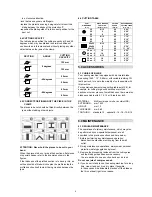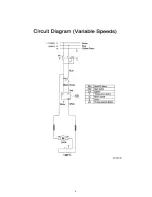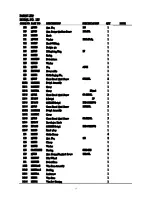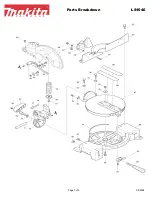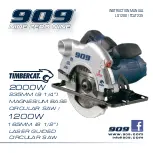
6.2 ASSISTENCE
Should it be necessary to call qualified personnel for
operations of extraordinary maintenance, or in the case of
repairs, under guarantee or at a later date, you should
always contact an authorized service center or the factory
directly. If there is no service centre in your area.
6.3 DISPOSAL OF THE MACHINE
Once its operating activity is finished, the disposal of the
machine must take place through a ormal collection and
disposal Center for industrial waste.
7.0 TROUBLESHOOTING
PROBLEMS
CAUSES
SOLUTIONS SUGGESTED
Specialized personnel should check
the machine ; do not attempt to repair
the motor by yourself.
The motor does not work.
Defective motor, power cable or plug.
Check fuse integrity and replace, if
necessary.
Blown electric panel fuses.
Check for voltage in the mains system.
No voltage in the mains system.
Release the run button and wait a few
minutes for the overload cutout to
reset.
The overload cutout has tripped.
Check that motor air intakes are clear.
Overload cutout tripped. Motor
overheating.
Perform the cut on the piece at the
correct pressure.
Motor overload caused by excessive
cutting pressure.
Specialized personnel should check
the machine ; do not attempt to repair
the machine by yourself.
Motor breakdown.
Inaccurate cutting angle at
90
∘
- 45
∘.
The setting of the H and K retainers
(point 3.3) is inaccurate.
Set the retainers by unloosening the
fastening screws and re-positioning
them.
Decrease cutting pressure.
Inaccurate cut squaring.
Excessive cutting pressure (on pipes
and section bars).
Check the cutting parameters (blade
toothing, cutting speed ) in the cuts
table (point 4.6).
Incorrect blade toothing in relation to
the piece to cut.
Check blade-guide adjustment (points
3.5 and 3.6).
Incorrect adjustment of the eccentric
and sliding blade-guides.
Check piece positioning and clamping
in the vice (point 4.5).
Incorrect cutting speed in relation to the
piece to cut.
Check blade tension (point 3.1).
The piece is wrongly positioned in the
vice.
Poor blade tension.
Check the cutting parameters (blade
toothing, cutting speed ) in the cuts
table (point 4.6).
Cut finish is coarse or corrugated.
The blade is worn or its toothing is not
right for the thickness of the piece
being cut.
Decrease cutting pressure.
Excessive cutting pressure.
Check eccentric blade-guide
adjustment (point 3.6).
The blade tends to protrude from the
guides.
Excessive blade tension.
Specialized personnel should check
the pulleys and replace them if
necessary.
Incorrect eccentric blade-guide
adjustment.
Never use any type of lubricant or
coolant for the cutting operations;
specialized personnel should check
and, if necessary, replace the pulleys.
Excessive wear of the pulley rubber
linings.
The blade slips on the pulleys, caused
by oil or grease required for cutting
operations.
Check blade tension (point 3.1).
7








